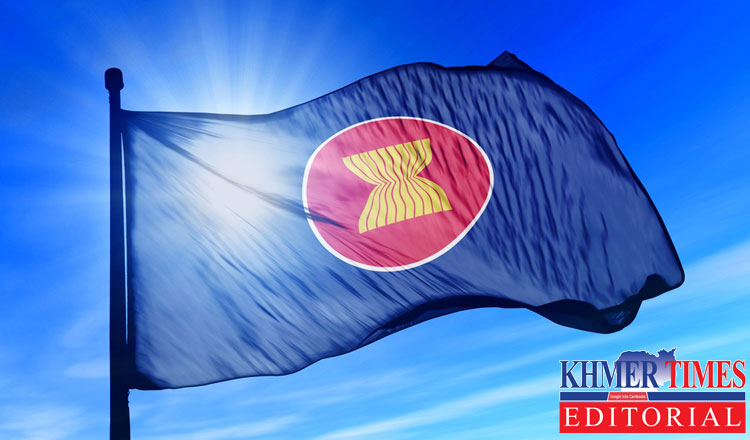There is a tendency for media and public opinion to overly focus on the political security aspect of ASEAN. Indeed, the aspect is of high importance because without peace, a wide spectrum of cooperation and community building efforts cannot be done.
Nonetheless, with the intensification of superpower rivalry, while ASEAN can be flattered to receive unprecedented attention, it can also be submerged with agenda of superpowers and get lost from our own goals for the sake of community interest.
While ASEAN is being praised for being the center for specific geopolitical strategies of superpowers and major powers, in other words, it also means that ASEAN is becoming the central platform for superpower and major power rivalries.
There can be optimistic view that competition between major powers creates balance of power that in turn supports stability and prosperity of the region. But this narrative is only partially completed. We need to remind ourselves that geopolitical competition and rivalry had been pursued at the expense of peace for some part of the region during the 1970s and 1980s.
This lesson should not be forgotten, and not least, be repeated in the region. Being the theater for superpower and major powers rivalry does not serve the whole region well, if history is of any reminder for all of us.
For ASEAN, political security is not all about confrontation and rivalry. And ASEAN is not all about political security either.
For the benefit of our community, apart from the maintenance of peace and security, we need to constantly think about what kind of tangible benefits that the ASEAN community bring towards people in the region. How could the ASEAN community support the betterment of people’s livelihood in the region? This is where the economic pillar comes into play.
When Covid-19 is still looming, the prospects for the economy is gloomy as countries look internally for economic security and survival, and resorted to de-globalization, or at worst protectionism. Ensuring resilient economic recovery, revitalising post-pandemic competitiveness are among the key economic priorities for ASEAN in the near future.
To that end, among many areas of cooperation, three key areas should deserve stronger attention from media and public opinion.
Firstly, revitalisation of trade. We don’t have much optimistic economic news at the moment. However, at the beginning of the year 2022, at the start of Cambodia’s chairmanship of ASEAN, the Regional Comprehensive Economic Partnership (RCEP) Agreement will enter into force. This is a great positive light amid the gloomy global economic situation. It is worth to note that RCEP negotiation was launched in 2012 in Cambodia, and will enter into force in 2022, also during Cambodia’s chairmanship. Of course, it is not a credit for Cambodia alone but for all the participating members who believe in multilateralism, and rule-based international trade. It is a beacon of hope against trade protectionism when geopolitical rivalries also affect trade and economic aspects.
All countries in the region need to make sure that all interested parties and stakeholders are well aware of the benefits from RCEP so that they can maximise opportunities from this mega trade agreement for the interest of the people in the region. In the process, local MSMEs and women and youth entrepreneurship should be targeted for leveraging benefits from the RCEP.
Apart from that ASEAN also continues to make strides on the Plus One Free Trade Areas (FTAs). The upgrade for the ASEAN, Australia, New Zealand FTA (AANZFTA) is currently under negotiations, with a targeted conclusion date of September 2022. Discussions are under way to conduct a review or study of the ASEAN-Korea FTA (AKFTA), ASEAN-China FTA (ACFTA), and the ASEAN-India Trade in Goods Agreement (AITIGA), to explore areas that could be considered in possible upgrade negotiations.
ASEAN is also making progress with potential new FTA partners. ASEAN has agreed, at the official-level, on a reference paper for a possible ASEAN-Canada FTA. In addition, Hong Kong, SAR has expressed their interest in acceding to the RCEP; while Chile has requested to join the AANZFTA.
Secondly, on digital economy. Covid-19 has highlighted the importance of digital space in our new normal, from economic exchanges, business platforms, education and even the countless meetings through videoconference.
The ASEAN Digital Masterplan 2025 (ADM2025) which was endorsed by ASEAN Digital Ministers in January 2021 provides the strategic direction for ASEAN to emerge as a leading digital community and economic bloc, powered by secure and transformative digital services, technologies and ecosystem. Recognising the opportunity of the entry into force of the ASEAN Agreement on E-commerce to spur significant economic growth and the regional economic integration, the 53rd ASEAN Economic Ministers’ Meeting in September 2021 endorsed a Work Plan on the Implementation of the ASEAN Agreement on E-commerce 2021–2025 which specifies a harmonised approach for all members to conform with the commitments while aligning their laws and regulations with international best practices.
But this area is not without challenges. There are gaps of laws on policies, and there are also gaps on digital infrastructure and supporting ecosystem. Moreover, this area is not immune from geopolitical rivalries either. Digital technology is also an area of geopolitical divide and decoupling, which has pressured on market choice and market freedom of states when major powers are campaigning for mutual exclusion, restriction and discrimination of technologies, platforms, and supporting infrastructure. The rivalries can create complexities for development.
Inter-operability between and among different origins of technologies should be further enhanced if major powers are keen for healthy competition and care for common interest of end-users. Digital taxation is also a matter for discussion when small countries and small markets have little means and leverage to implement.
Thirdly, on connectivity. Undoubtedly, physical infrastructure connectivity is the most feel-able tangible benefits for people in the region.
Linking of transport and logistics system has enhanced intra-regional trade, economic and people-to-people exchanges, and also the sense of community for people in the region. This is what make people proud to be ASEAN when people can travel across countries more conveniently for business, education, works and leisure.
Chaired by Cambodia, the ASEAN Transport Ministers met in November this year to discuss and lay the ground work for post Covid-19 recovery by focusing on building sustainable and resilient connectivity.
ASEAN is also working to encourage the promotion, development and operationalisation of Sustainable Urban Mobility Plans (SUMP) and the Metropolitan Transport Executive (MTE) model in ASEAN Member States, though the issuance of Phnom Penh Declaration on Sustainable Urban Mobility by the ASEAN Transport Ministers in November 2021.
This benefit also holds true vis-à-vis ASEAN’s relations with external partners.
For instance, the successful completion of the negotiation on the ASEAN-EU Comprehensive Air Transport Agreement (AE CATA) in June 2021 is another milestone to strengthen air connectivity between and beyond ASEAN and Europe. There are also ongoing Air Services Agreement (ASA) negotiations with Japan, New Zealand and ROK.
With China, the meeting welcomed the adoption of the draft 2021-2025 Action Programme of the Revised Strategic Plan for ASEAN-China Transport Cooperation. With Japan, the two deliverables were the Report on Proof of Concept (PoC) on ICT Solutions for Over-loaded Vehicle Control; and ASEAN-Japan Certification Audit Guidelines on Cold Chain Logistics Standards. The meeting also welcomed the new initiative on Utilisation of Big Data to Improve Mobility under the ASEAN-Japan Transport Partnership (AJTP) Work Plan for 2021-2022.
As with the U.S., we are working toward establishing a formal dialogue on transportation which will start at senior official levels. The 1st ASEAN and the U.S. Senior Transport Officials Dialogue (ASEAN-U.S. STOD) will be held in 2022.
The above are merely a small capture of economic aspects of ASEAN community building efforts.
ASEAN people should be able to benefit directly from these efforts of cooperation through concrete and practical activities, and projects. Beautiful speeches and super grand inter-continental schemes without concrete activities and funding don’t deliver tangible benefits to the people.
Healthy competition can bring benefits for people, but rivalries can disrupt development and cooperation at the expense of interest of the people who are keen to understand what ASEAN means to them and the region.
Sim Vireak
Strategic Advisor of the Asian Vision Institute (AVI)
Source: https://www.khmertimeskh.com/50991389/economic-aspects-of-asean-community-building-efforts/



